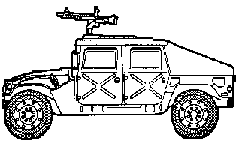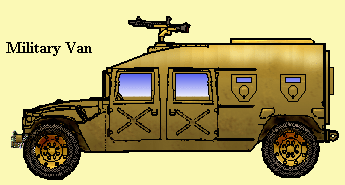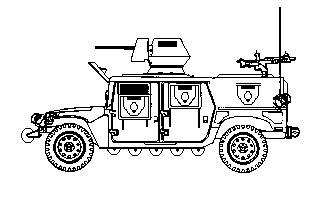 Include a firing port in the side shutters. Providing a forward firing port for the co-driver would be a good feature, as would the facility to fire additional weapons to the rear.
Include a firing port in the side shutters. Providing a forward firing port for the co-driver would be a good feature, as would the facility to fire additional weapons to the rear.Added 7-5-02
Updated 1-9-23
When I first wrote this page, my main concern was improving the capabilities of the HMMWVs used as reconnaissance vehicles.
Now the same vehicles are being used for the defence of convoys in Iraq, a role for which they are proving to be disastrously insufficient for. HMMWV Armament Carriers have neither the power nor the design features to give them a reasonable chance against common threats such as RPGs and command-detonated mines.
All such vehicles need to be withdrawn from the Iraq theatre of operations and their role taken over by 2½t and 5t trucks configured as Guntrucks.
Decades after I wrote this article, I come across the following article and webpage:
Much of the Scrapboard is logical deduction, so it actually reassuring that others have similar ideas.
That said, I no longer support the idea of using HMMWVs for reconnaissance. Contary to the opinion of the author, the HMMWV is far from ideal for many roles.
Some of the suggested modifications may be useful for HMMWVs used for other purposes.
See this article for more up-to-date discussion.

These two pictures are of two vehicles that perform a similar role: the BRDM(above) and the machine gun car version of the HMMWV(right), usually termed an “armament carrier”.
Most Russian brigades/regiments have a scout platoon and a chemical recon platoon of 3-6 BRDMs each. A divisional reconnaissance battalion had 12 scout cars and 4 NBC cars. A divisional chemical defence battalion had 9 NBC. A command car version is used by some battalion or battery commanders or in BRDM equipped units. Divisional anti-tank battalions and motor rifle regiments each had 9 of the ATGW-armed variant.
In contrast, the US has tried to equip whole regiments and even a division with HMMWVs.

The most obvious difference is that the HMMWV has lots of windows. These are bullet-resistant, but canot protect the occupants if wound down, as they often will be. In hot environments, the closed windows will let in sunlight and trap heat, turning the inside of the vehicle into a greenhouse. Such windows will also reflect light, revealing the vehicle's position.
The BRDM has a turret, mounting two machine guns: a 7.62mm GPMG and a powerful 14.5mm VHMG. The HMMWV can mount only one weapon, usually a 7.62mm MMG, .50 HMG or a Mk-19 Grenade launcher.
More critically, the gunner has no protection from counter fire. In Vietnam it was found that unshielded gunners on vehicles had an unacceptably high casualty rate, yet more than 30 years later and after the same findings in Somalia, vehicle gun shields are the exception rather than the rule.
The BRDM has lateral firing ports, so that crew can fire at ambushers without needed to expose themselves by winding down windows.
The BRDM has a set of retractable belly wheels for extra traction during cross-country operation.
The BRDM has an exhaust fitting that can produce smoke if pursued.
Despite being the heavier vehicle, the BRDM is fully amphibious and propelled by a water jet, while the HMMWV can ford 5ft with preparation, or two and a half feet without.
The large number of M1025s, M1114s etc are likely to be in service for some time. Is there a quick and simple way to make them more effective scout cars?
 Include a firing port in the side shutters. Providing a forward firing port for the co-driver would be a good feature, as would the facility to fire additional weapons to the rear.
Include a firing port in the side shutters. Providing a forward firing port for the co-driver would be a good feature, as would the facility to fire additional weapons to the rear.Obviously many of these improvements could be implemented by a unit's own maintenance staff.
Scout cars are not the only form of HMMWV in service, but many of the other models could be replaced by just two basic variants:
 |
 |
One type would be a HMMWV “pickup truck”. This is essentially the M1097 model. Add on modules could adapt it to various roles such as bowser, command post etc.
The other type that could meet most military needs would be a HMMWV of transit-van configuration, which could be used to move both cargo and personnel.
A more detailed article by Mike Sparks on improving the HMMWV.
Ed Sackett writes:
The military van is the configuration I like best, because it offers the most cubic space inside and has a back door.
PW: It also has roof hatches. Been thinking recently about the Anti-armour companies that are organic to some infantry battalions. Suppose there was little armoured threat or the firing post is removed to support a defensive position. Any intelligent commander is going to try and use those HMMWVs for patrolling and transport. This makes me think that at least some of the Battalion's TOW-HMMWVs should be van configuration. Alternately they can be mounted with 106mm Recoilless rifles in certain situations.It would log most of its kilometres hauling stuff rather than men (and pulling loaded trailers, something tells me). I'll get back to you on those belly rollers; I fear they might cause bogging-down rather than preventing it: they add no traction. The front roller is a good old idea to bring back, in part because it's so cheap. Some jeepers would rather have a power winch instead, but I don't see why you couldn't have both.
My latest thoughts are to place a large bandtrack around the rollers to spread the weight and reduce friction. I'm thinking unpowered -they just spread the weight while the wheels/winch provide power.
Heck, with that monster of an engine available, I think we can & should power any type of auxiliary traction. Even -I- am too young to remember White chain-drive trucks, but I'm old enough to picture a simple sprocket and chain arrangement between a Hummer wheel hub and the leading roller. Would there be vivid blaspheming as the assistant driver lugged it out and installed it in thick mud and freezing rain? Yes, and a good lesson for him.
Maybe HMMWVs could be replaced by an updated version of the M8/M20 Greyhound, possibly using some HMMWV components? The M8/M20 has a superior shape for deflecting fire, and seems to have enjoyed good mobility for a wheeled vehicle. A reconfigured vehicle such as this could easily be made amphibious. Possibly a Hybrid Electric Drive system could be fitted, making the vehicle even more capable in the recon role.
During the US Army and USMC's “Thunder Runs” into Baghdad, HMMWV armament carriers drove into the city alongside tanks and APCs. One can only guess that more of these vehicles were not lost to enemy fire because the tracked armour were the preferred targets.
Currently HMMWVs are being used to patrol the roads of Iraq, and are the preferred targets, since HMMWVs usually contain Americans.
Car-configuration armament carriers such as the M1025/M1114 have many objectionable features:
The first is that they only have four seats. It may be possible to squeeze a few more bodies inside, but if you are bouncing cross-country or there is a likelihood of hitting a mine you want to be strapped in.
Space for cargo is also limited. There are many smaller vehicles that can carry more men or cargo across country more effectively.
Prior to the adoption of the HWWMV, most military vehicles of this class were open-topped with a canvas canopy for weather protection. The HMMWV armament carrier has an enclosed cabin like a civilian car.
As we all know, travelling in a car can often create a sense of detachment from the surrounding world, which is the last thing one wants in a combat zone. Being enclosed, and the large size of the vehicle probably helps create a false sense of security for the crew.
Many HMMWVs designated as being “armoured” in fact are only spall-resistant and cannot withstand direct small arms fire.
All of the seats face forward, which further contributes to poor situational awareness for the crew.
The rear cargo hatch lacks a window, so the only view to the rear is from the wing mirrors or from the gunner's position, should he be looking that way.
For any vehicle the rear is the preferred target for RPG operators.
Up-armouring HMMWVs will give some protection against small arms or mine fragments, but one of the main threats on the roads of Iraq are RPGs. A HMMWV can never carry enough armour to resist an RPG hit. The only defence against such an attack is situational awareness combined with suitable armament.
There are currently proposals to improve the protection of the HMMWV fleet by adding more armour. It may be time to address the configuration of some of these vehicles too.
 The armament carrier version of the HMMWV needs to have its rear section redesigned so the vehicle becomes an “estate”. Civilian Hummers and many Land Rovers already use this configuration.
The armament carrier version of the HMMWV needs to have its rear section redesigned so the vehicle becomes an “estate”. Civilian Hummers and many Land Rovers already use this configuration.
This configuration would allow bulkier cargo to be carried and the rear door would allow the emergency transport of a litter-borne casualty.
This rear-section would have roof-hatches to improve all round observation by allowing any crew not in the front to travel heads-up and observe quadrants not watched by the gunner. Such a modified HMMWV would somewhat resemble a lightweight version of the White M3 Scoutcar.
This unarmoured HMMWV in Iraq with improvised armour designed by Capt. Darryl Butler has many of the features I propose adopting for Armament Carriers.
I suggest a hatch in the roof for another machine gun, and mesh over the windows to allow air in but keep grenades out.
At least one HMMWV has been destroyed by a grenade thrown through an open window when the vehicle was in urban surroundings.
The US Military has vast numbers of Abrams Main Battle Tanks, Bradley Fighting Vehicles and versatile M113s.
Given such assets, it is rather bizare that there are repeated attempts to us the HMMWV armament carrier as an assault vehicle.
An armament carrier weighs under four tons. Most vehicles that have been successful in an assault role weigh 10-70 tons, much of this weight being armour.
The HMMWV may have uses as a combat vehicle, but a simple rule needs to be observed:
Never let the enemy get within RPG-range!
If you are in any situation where the foe can approach to within 400 yards, it is time for a rethink.
The role of the HMMWV as a convoy escort needs consideration.
The HMMWV is the preferred target of the ambusher.
Larger vehicles such as trucks offer better protection against both mines and RPGs, can carry a greater weight of armour and carry more eyes and guns to spot and suppress a threat.
The M1117 ASV is undoubtedly a better choice as an escort vehicle, and the creation of an APC version along similar lines to the 7½ ton Humber “Pig” may be prudent.
If HMMWVs are used on roads it should be in the company of larger, better-armed vehicles.
As things stand at the moment, we are just offering our foes easy kills.
When I originally wrote this page, the topic was on how to improve armoured HMMWVs, mainly in the role of reconnaissance vehicles.
What is not widely appreciated is that the armoured models of HMMWV that pre-date the M1114 are not “bullet-proof”. They were designed to have bodywork that is spall-resistant, with bullet-resistant windows.
The majority of HMMWVs being used in Iraq do not have even this level of protection: they are unarmoured vehicles.
In a counter-guerrilla conflict, there are no safe areas.
Placing troops in unarmoured vehicles simply gives the enemy easy physical and propaganda victories.
For the first few months of the occupation, soldiers in many units were forbidden to add protection to their vehicles.
One wonders how many lives have been lost needlessly because of this.
Although we are now seeing attempts to harden vehicles, the potential of this is limited.
A full-size truck can carry a useful weight of sandbags, armour and armament. The truck bed and cabin are some distance off the ground, giving some protection from mines.
This is not the case with an unarmoured HMMWV. It can only carry a relatively modest weight before the suspension becomes overtaxed.
Naively, the HMMWV was only designed to withstand anti-personnel mines. Its underside lacks the blast deflection features that were developed for light vehicles in Rhodesia and South Africa in the 1970s, or that are incorporated into vehicles such as the RG-31 and RG-32.
Conversion of an unarmoured HMMWV into a protected vehicle must consider features such as the suspension and mine-protection.
Unarmoured HMMWVs should not be used in theatres where there is a high likelihood of guerrilla activity.
All such vehicles in Iraq should be withdrawn and replaced with more capable systems or by purpose-designed armoured HMMWVs that at least offer small-arms protection.
Commanders and crews must be aware of the limitations of armoured HMMWVs and not use them in environments where RPGs can be brought into range.
By the Author of the Scrapboard : | |
|---|---|
 | Attack, Avoid, Survive: Essential Principles of Self Defence Available in Handy A5 and US Trade Formats. |
 | |
 | Crash Combat Second Edition with additional content. Epub edition Second Edition with additional content. Crash Combat Third Edition Epub edition Third Edition. |
 | |
 | |